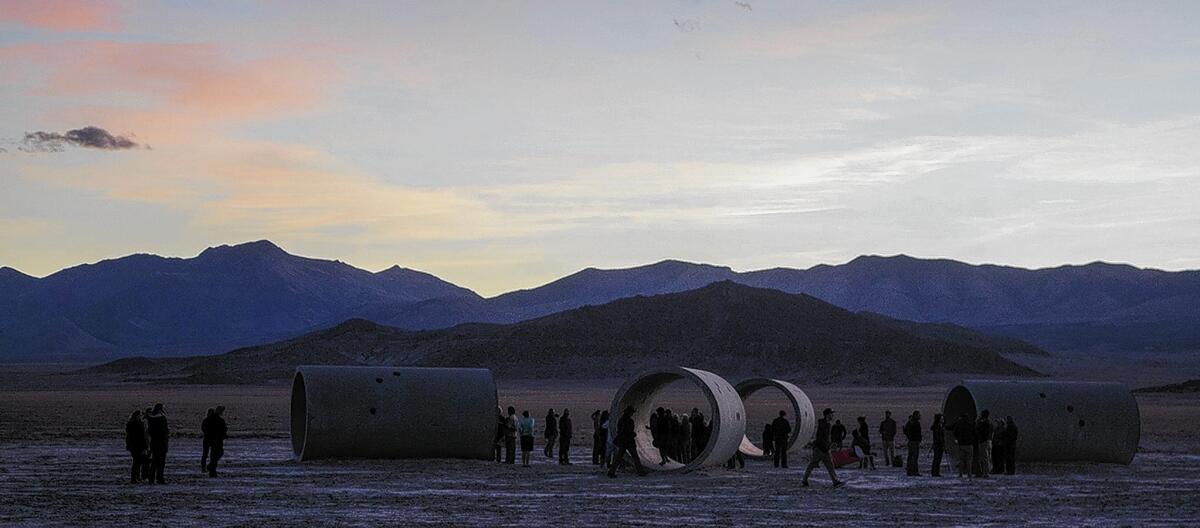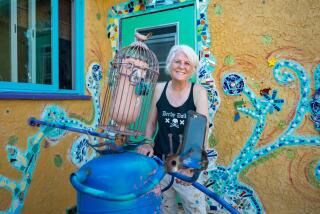Nancy Holt dies at 75; her art interacts with the land and sky

Artist Nancy Holt’s best-known work, “Sun Tunnels,” is outdoors, huge and open to the public — but only a relatively small number of people have seen it in person. It sits on 40 acres of land she bought in a desolate part of the Great Basin Desert in northwest Utah, accessible only by dirt roads with no buildings in sight.
There sit four massive concrete tubes, each weighing 22 tons and towering more than 9 feet tall. The tubes are precisely oriented to frame not only landscapes in the distance but also the ever-changing patterns of the sun and stars in the sky. By limiting what someone in a vast open space can see, Holt meant to make the universe more personal.
“‘Sun Tunnels’ was a way of bringing the universe back to human scale,” she said in a 2012 interview with the Telegraph newspaper in London. “It was a way of orienting one in space and time.”
Holt, 75, died Feb. 8 at Memorial Sloan Kettering Cancer Center in New York. The cause was leukemia, her friend Carlotta Schoolman said.
As a young artist in New York’s West Village in the mid-1960s, Holt worked in far more common — and practical — media for her creative outlets, including photography and poetry. But in 1968 she landed in Las Vegas for the first time, and it changed her life.
“We stepped off the plane into the vastness of the desert,” she said in an interview for “Nancy Holt: Sightlines,” a 2011 book for a traveling exhibition of her work. “I had an overwhelming experience of my inner landscape and the outer landscape being identical. It lasted for days. I couldn’t sleep.”
Joining her on that trip were kindred spirits, in regard to using the landscape in art: her husband, Robert Smithson, and Michael Heizer, both pioneers in the land art movement. Smithson’s seminal work is “Spiral Jetty” (1970), a 1,500-foot-long coil of black basalt rocks that stretches out into the Great Salt Lake.
Holt called her first land art pieces “Locater” works, consisting of short pipe viewing devices that limited the view of indoor and outdoor spaces. “Sun Tunnels” greatly expanded that concept. In 1973 she was unloading from her car cardboard tubes to create a model of the work when she got the news that Smithson was killed in a small-plane crash while surveying a site for an upcoming project. “It was unbelievable,” she said in the Telegraph interview. “Bob was 35 — so young. But he had done a lot already.”
She took it upon herself to finish some of the works he had planned, starting with “Amarillo Ramp,” the piece he was working on in Texas when he was killed. “She spent a lot of her life looking after the legacy of her late husband’s career,” said Ben Tufnell, who curated an exhibit of Holt’s photographic and other works in London in 2012. “Often, she would put Bob’s work first, and I think that was at the expense of her own career.”
Another factor in her relative obscurity is that she seldom made art that could fit inside museums or galleries. “She didn’t play the gallery game,” Tufnell said.
In 1974, she bought the Utah land for “Sun Tunnels” for $40 an acre. The concrete tubes were custom made according to her design, and she collaborated with a large team — including an astronomer, engineers, a crane operator, a helicopter pilot and on-the-ground workers — to install the 18-foot-long structures laid out in a disjointed X configuration. The formal opening was June 21, 1976, on the summer solstice. That was significant because during the twice-a-year solstices, a pair of tubes align directly with the sun at both sunrise and sundown.
Alena Williams, who curated the “Sightlines” exhibition, said that as an art piece, “Sun Tunnels” feels far larger than just the viewing tubes. “There is a ridge of hills that surround the land that she has, so maybe that’s the ultimate limit of the work,” Williams said. “And at night, it’s maybe the sky beyond that.”
Nancy Holt was born April 5, 1938, in Worcester, Mass. She graduated from Tufts University in 1960 with a bachelor’s degree in biology. Although she moved to New York shortly after college and got involved in the arts scene, her works in land art, photography and videos often had astronomical and other scientific elements. She and Smithson married in 1963.
After “Sun Tunnels,” Holt received several commissions. Among the best known was the design of Dark Star Park in the Rosslyn, Va., neighborhood just outside Washington. She created large spheres of gunite, suggesting extinguished stars, to be placed in the park amid small water features and greenery. Some of her projects fell through, including one for Santa Monica’s beach called “Solar Web” that was to be constructed of black steel pipes, pointed toward the ocean. Construction was to begin in 1989, but it was canceled after beach property owners protested that it would clutter their views of the ocean.
A major project that did go through was “Up and Under,” a winding, 630-foot-long earthwork in a former sand quarry in Finland. It was Holt’s most ambitious work, made of sand, concrete, topsoil and other materials, with seven tunnels that people could walk through. It opened to the public in 1998 after 10 years of development and construction, but reception of the work was muted. Holt did not hide her disappointment, though she was not about to make works with more merchandising possibilities.
“You have to put a lot of energy into staying viable in the art world,” Holt told the Telegraph. “It’s important to stay in the public eye, yes. But I don’t want to spend every living moment putting energy into that.”
Holt was an only child and has no survivors.
More to Read
Start your day right
Sign up for Essential California for the L.A. Times biggest news, features and recommendations in your inbox six days a week.
You may occasionally receive promotional content from the Los Angeles Times.







